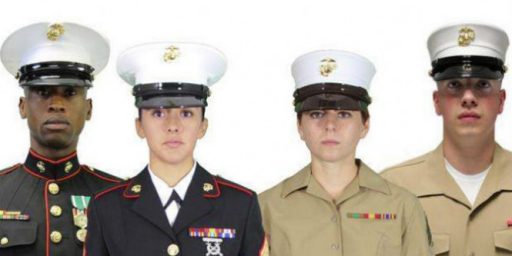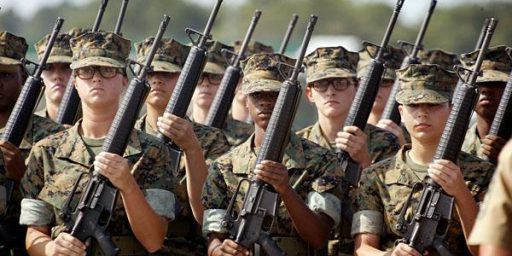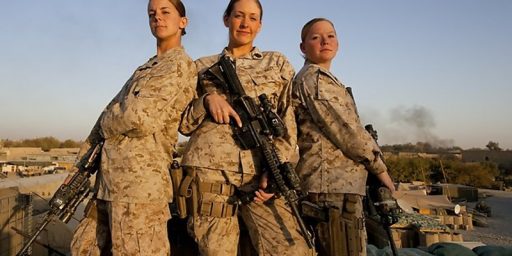Snipers and Sharpshooters
James Dunnigan has an interesting piece entitled, “Snipers and Sharpshooters Rule the Battlefield.”
In Iraq, the The U.S. Army and Marines both found that more frequent and aggressive use of snipers made for more successful combat operations. Each army brigade now has about three dozen trained snipers, and most brigades have encouraged the selection and training of more snipers within infantry companies. The ability to take down enemy troops with single shots is a major combat advantage, but can only be done if you have better trained troops and much better reconnaissance and observation on the battlefield.
The army has a five week sniper school, and the marines have a ten week course that is considered one of the best in the world. These schools turn out professional snipers who know how to operate independently in two man teams. Marine regiments (about the same size as army brigades) have about three times as many snipers per battalion as do army units. But both the army and the marines are taking advantage of the greater number of veteran troops in their combat units, and the fact that just about every soldier has a rifle with a scope, and has a lot of target practice behind them. Infantry commanders are encouraged to find and designate about ten percent of their men as “sharpshooters†(sort of “sniper liteâ€) and make use of these guys to take out enemy troops at a distance, and with single shots. This is a trend that has been growing for over a decade, but has now become a major feature of American infantry tactics.
The marines won̢۪t release any numbers of sniper kills (except that the top scoring sniper in Fallujah had 24 kills as of late April), but it is known from emails coming back that the marines use snipers, and sniping tactics (for non-snipers), extensively. Part of this is to comply with the Rules of Engagement (ROE) that call for minimizing civilian casualties. Most often, the marines only use a lot of fire power when they are ambushed (there is no better way to deal with an ambush than to blast your way out of it). But most of the Iraqi gunmen are killed by single shots, usually by the trained snipers, after the snipers and their commanders had carefully set up sniper firing positions that covered areas they knew Iraqis liked to travel through. UAVs and lots of scouting, plus questioning of prisoners, reveals the Iraqi routes and makes them deadly to use. This has terrorized the Iraqis, which is exactly what it is intended to do. The army and marine snipers particularly like to work at night, when their night vision and thermal imaging equipment enables them to shoot accurately in the darkness. This further reduces the chance of civilian losses, and increases the terror.
The men who go through the sniper school receive lots of training on how to choose a good shooting position, get to it unseen and remain unseen for as long at is takes to get the shot, or shots, available. These professional snipers also learn to use larger caliber 7.62mm and 12.7mm (.50 caliber) sniper rifles. These are single shot weapons that are designed and built for accuracy at very long ranges (over a thousand meters for the 12.7mm rifle.) The “sharpshooters†are mainly excellent shots at shorter ranges, and have whatever training they can pick up on how to find the best shooting position. Army and marine officers have learned how to use snipers more frequently in the past two decades. Instead of regarding the snipers as just a specialized weapon, for special occasions, combat unit commanders now see snipers as a standard type of trooper, to be used immediately in any combat situation, just as they would mix and match riflemen, machinegunners, grenadiers (with 40mm grenade launchers) and other weapons available to infantry companies and battalions.
The emphasis on greater accuracy in the use of weapons now applies to all weapons. Better trained troops can carry out complex battlefield maneuvers automatically, even when (especially when) under fire. While some of the anti-government gunmen in Iraq have demonstrated evidence of some military training, it has proved far inferior to that of the American troops they face. In combat, the side that is better trained wins, and takes fewer casualties doing so.
A very low-tech solution to the problem. Indeed, snipers are the ultimate smart weapon.






James,
Have to argue with your conclusion about sniping being a “low tech” solution.
The sniper weapons are probably far more precision engineered than the .22s I fired in summer camp. Also, the article points out that today’s sniper teams rely on “night vision and thermal imaging equipment” which give a helluvalot better accuracy than the metal-sighted .22s referenced above. All together the sniper’s black bag contains some pretty high tech tricks, albeit low-key.
Perhaps what you meant to say was that the sniper method of enemy attrition is much less sexy than a Bruce Willis/Jean Claude Van-Damme-esque blowing up of stuff.
Well, it’s low tech compared to Predators and the various gee whiz Air Force stuff! It’s basically still just a man an his rifle, although with some technical assistance.
I know some trained snipers, and can tell you that the equipment is *very similar* to what SWAT and other police sharpshooters use. Both the Barrett and the Macmillan 12.7 mm (.50 Cal) rifles have been in use by Marine teams since the first Gulf War, and are specialized only in that special scopes have to be made for them in order to stand up to the recoil. What has changed is tactics and tactical doctrine. The Marines, especially, are teaching some of the lessons learned in the WWII Italian campaign to a whole new generation.
James,
Are you sure the guy who wrote this article knows whereof he speaks? For the most part, a good article. My beef is with the following declaration; “These professional snipers also learn to use larger caliber 7.62mm and 12.7mm (.50 caliber) sniper rifles. These are single shot weapons that are designed and built for accuracy at very long ranges….”
Excuse me, but 7.62mm is THE standard caliber for Marine snipers. AKA .30 caliber, AKA .308 Winchester in the civilian world. These are not used in single shots but in bolt action, highly tuned hunting rifles. The article seems to imply that snipers use M16s and that is simply not the case.
—